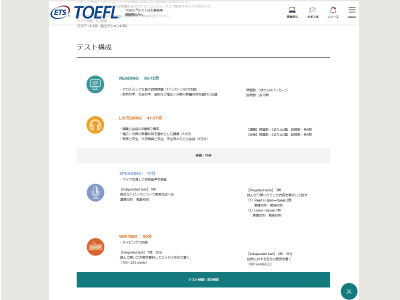TOEFLテストや英語学習を通してグローバル人材になるためのヒントをお届けします。
- トップページ
- ETS公認トレーナー直伝 TOEFL iBT®テスト 対策、ここがポイント!
- 第18回 TOEFL iBT®テスト Reading対策No. 5 Inference問題を攻略しよう!その1

2014.08.26
第18回 TOEFL iBT® テスト Reading対策No. 5
Inference問題を攻略しよう!その1
皆さんこんにちは。台風やら暑さやらでなかなか大変な夏ですが、いかがお過ごしでしょうか。私は8月中、TOEFL iBT® テストスキルアップセミナー(*)などで各地を廻ってきました。これらのセミナーなどの様子は、前回(第17回 TOEFL iBT® テスト Speaking対策 No.5 Integrated Task 4の対策法と演習)のように動画などでお伝えできればと思っています。
さて今回の連載は、第13回(TOEFL iBT® テスト Reading対策No. 4 Basic Comprehension Questions(cont’d))に引き続きReadingについてです。
以前お伝えしたように、Readingの問題カテゴリには
- 1)Basic Comprehension Questions
- 2)Inference Questions
- 3)Reading to Learn Questions
の3つがあります。今回からは2)Inference Questionsを扱っていきましょう。
Inference Questions―注意点
まずInferenceとはどんな概念かを復習しましょう。The American Heritage Dictionaryの定義によりますと、
Infer = To indicate indirectly; imply. To conclude from evidence or by reasoning.
とあります。Key wordとしては “indirectly(間接的に)”、“evidence(証拠)/reasoning(推論)”でしょう。これをReadingの問題と照らし合わせてみると、以下の事が言えます。
- 注意点1:
- パッセージに直接的には書いていなくても、パッセージの内容と合っている、もしくは内容から推測することができる
- 注意点2:
- Detail Questionsとは違い、書いてないから、また単語が違うから、といって選択肢を消去してはいけない。あくまでも書かれている情報から推測できるか、が重要
- 注意点3:
- 「推測」とは言え、全く各自で勝手な推測をしてもらっては困る。あくまでも「書いてある情報を基に推測できる範囲内で」が基本
- 注意点4:
- 解き方は基本的にDetail Questionsと同じ。設問文の中にあるヒントで根拠の記述箇所を探す。答えの根拠は必ずどこかに(間接的に)書いてあるので、それを見つけ、その情報から推測する
ちなみにInference Questionsの出題形式にはいくつか違いがありますが、設問文に以下の単語やフレーズがでてきたら当てはまります。
- ― infer
- ― imply
- ― suggest
- ― support
- ― most/least likely to agree
また設問によっては、
“What can be inferred from the passage?”
などのように、設問文にKey wordとなる単語がない場合もあります。その時は以下のように対処しましょう。
- 注意点5:
- 問題にヒントがないときは、各選択肢からヒントを探し、手間がかかってもそれぞれを検証する。当てはまらない選択肢を消去する
Inference Questions―サンプル問題
それでは早速Inference Questionのサンプル問題を解いてみましょう。1回目は辞書などを使わず、本番のつもりで解いてみてください。
How did this tremendous development take place, and why did it happen in the Teotihuacan Valley? Among the main factors are Teotihuacan’s geographic location on a natural trade route to the south and east of the Valley of Mexico, the obsidian resources in the Teotihuacan Valley itself, and the valley’s potential for extensive irrigation. The exact role of other factors is much more difficult to pinpoint—for instance, Teotihuacan’s religious significance as a shrine, the historical situation in and around the Valley of Mexico toward the end of the first millennium B.C., the ingenuity and foresightedness of Teotihuacan’s elite, and, finally, the impact of natural disasters, such as the volcanic eruptions of the late first millennium B.C.
(Paragraph 3)
This last factor is at least circumstantially implicated in Teotihuacan’s rise. Prior to 200 B.C., a number of relatively small centers coexisted in and near the Valley of Mexico. Around this time, the largest of these centers, Cuicuilco, was seriously affected by a volcanic eruption, with much of its agricultural land covered by lava. With Cuicuilco eliminated as a potential rival, any one of a number of relatively modest towns might have emerged as a leading economic and political power in Central Mexico. The archaeological evidence clearly indicates, though, that Teotihuacan was the center that did arise as the predominant force in the area by the first century A.D.
Q6. Which of the following can be inferred from paragraphs 2 and 3 about the volcanic eruptions of the late first millennium B.C.?
- (A)They were more frequent than historians once thought.
- (B)They may have done more damage to Teotihuacan than to neighboring centers.
- (C)They may have played a major role in the rise of Teotihuacan.
- (D)They increased the need for extensive irrigation in the Teotihuacan Valley.
Q7. What can be inferred from paragraph 3 about Cuicuilco prior to 200 B.C.?
- (A)It was a fairly small city until that date.
- (B)It was located outside the Valley of Mexico.
- (C)It emerged rapidly as an economical and political center.
- (D)Its economy relied heavily on agriculture.
<解答>
Q6―C
Q7―D
<解説>
Q6. 設問文中のKey wordsは “the volcanic eruptions of the late first millennium B.C.”ですね。また今回はParagraph 2と3の両方から情報を探す必要があります。
ここでは冒頭の質問“How did this tremendous development take place, and why did it happen in the Teotihuacan Valley?”に対する答えとして、factorの1つである “the impact of natural disasters”との例としてthe volcanic eruptions of the late first millennium B.C.が紹介されています。
(Paragraph 3)
冒頭で “This last factor”、つまりthe volcanic eruptionsについての説明が続いています。読み続けると、a leading economic and political power in Central MexicoとしてCuicuilcoが存在しているけれども、the volcanic eruptionsによってCuicuilcoが甚大な被害を受けてしまった、とあります。
両パラグラフからわかることは、「the volcanic eruptionsによって結果としてthe Teotihuacan Valleyが発展した」という事です。よって正解は(C)が一番近い内容になっています。
Q7. Key wordsは“Cuicuilco prior to 200 B.C.”ですね。ここで読むべきポイントは“Around this time, the largest of these centers, Cuicuilco, was seriously affected by a volcanic eruption, with much of its agricultural land covered by lava.”の部分です。特に下線部によると、Cuicuilcoの領土の農耕地の大部分が溶岩によって覆われてしまったわけです。結果、centerとしての機能を失ってしまったわけですね。言い換えれば、農耕地を失うことで機能が奪われた=農耕地がCuicuilcoにとっては重要だった、それだけたくさんあった、と推測できます。よって正解は(D)ですね。
いかがでしたか?Inference問題はやや難しい面を含みますので、引き続き対策・練習が必要です。頑張りましょう。
それではまた次回(第19回 TOEFL iBT® テスト スキル向上シリーズ その1 Summarizing Skill について)にお会いしましょう。
(*)TOEFL iBTテストスキルアップセミナーの予定はこちら

- 五十峰聖先生
- ETS Authorized Propell® Facilitator
ETS TOEFL ITP® Teacher Development Workshop Facilitator - 桜美林大学 芸術文化群 特任講師
- プロフィールはこちら

- TOEFL iBT®テスト テスト構成
- テストの問題数や内容はテスト構成をご確認ください。




